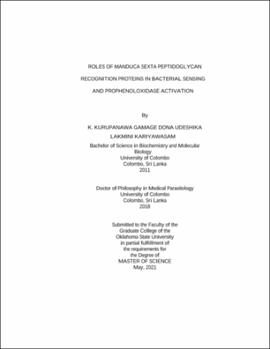| dc.contributor.advisor | Jiang, Haobo | |
| dc.contributor.author | Kariyawasam, K. Kurupanawa Gamage Dona Udeshika Lakmini | |
| dc.date.accessioned | 2021-09-24T13:58:04Z | |
| dc.date.available | 2021-09-24T13:58:04Z | |
| dc.date.issued | 2021-05 | |
| dc.identifier.uri | https://hdl.handle.net/11244/330926 | |
| dc.description.abstract | Insects, rely on their innate immune system as the first line of defense against invading microorganisms. Innate immunity is mediated by germline-encoded pattern recognition receptors (PRRs), such as TLRs, NOD-like receptors, and peptidoglycan (PGN) recognition proteins (PGRPs). These receptors induce interactions with pathogen-associated molecular patterns, to initiate innate immune responses by activating pathways that regulate the expression of antimicrobial peptides (AMPs). PGRPs are one of the most important types of PRRs found in insects and were first discovered in the hemolymph of silkworms as proteins that bind bacterial PGN and activate the prophenoloxidase (proPO) pathway to initiate melanization, which is an antimicrobial host defense mechanism in insects. The differential recognition of diaminopimelic acid (DAP) and Lys-type PGs is in fact common across the PGRP family. | |
| dc.description.abstract | Previous studies on Drosophila melanogaster showed that increase in spontaneous melanization was observed when PGRP-LE was over-expressed and Drosophila PGRPs prefer Lys-type PGNs than DAP type PGNs. However, specific recognition of different types of peptidoglycans by PGRPs and also how they regulate the proPO system are not yet fully understood in Manduca sexta. Therefore, this study is focused on determining the role of M. sexta PGRPs in bacterial recognition and proPO activation, and elaboration of their specificity towards different bacteria. Recombinant MsPGRPs were expressed in a baculovirus expression system and purified. To gain functional insights into the recognition of PGN and the activation of proPO pathways by MsPGRPs (MsPGRP 2, 3, 4, 5, 12 ecto and 13), binding specificity and proPO levels were analyzed in this study. | |
| dc.description.abstract | Taken together, our results from ELISA, pull-down assays with PGNs and live bacteria, and PO activity assays suggest that MsPGRPs 2-5 and 13 are positive regulators of the proPO activation system. They preferentially recognize DAP-type PGNs over Lys-type PGNs. Although the recent progress has brought us closer to understanding the role of M. sexta PGRPs in bacterial sensing and proPO activation, the precise mechanism of MsPGRP-PGN specific binding that leads to synergistic enhancement in the proteolytic activation of proPO in plasma need further investigations. | |
| dc.format | application/pdf | |
| dc.language | en_US | |
| dc.rights | Copyright is held by the author who has granted the Oklahoma State University Library the non-exclusive right to share this material in its institutional repository. Contact Digital Library Services at lib-dls@okstate.edu or 405-744-9161 for the permission policy on the use, reproduction or distribution of this material. | |
| dc.title | Roles of Manduca sexta peptidoglycan recognition proteins in bacterial sensing and prophenoloxidase activation | |
| dc.contributor.committeeMember | Soulages, Jose | |
| dc.contributor.committeeMember | Lei, Xia | |
| osu.filename | Kariyawasam_okstate_0664M_17140.pdf | |
| osu.accesstype | Open Access | |
| dc.type.genre | Thesis | |
| dc.type.material | Text | |
| thesis.degree.discipline | Biochemistry and Molecular Biology | |
| thesis.degree.grantor | Oklahoma State University | |
